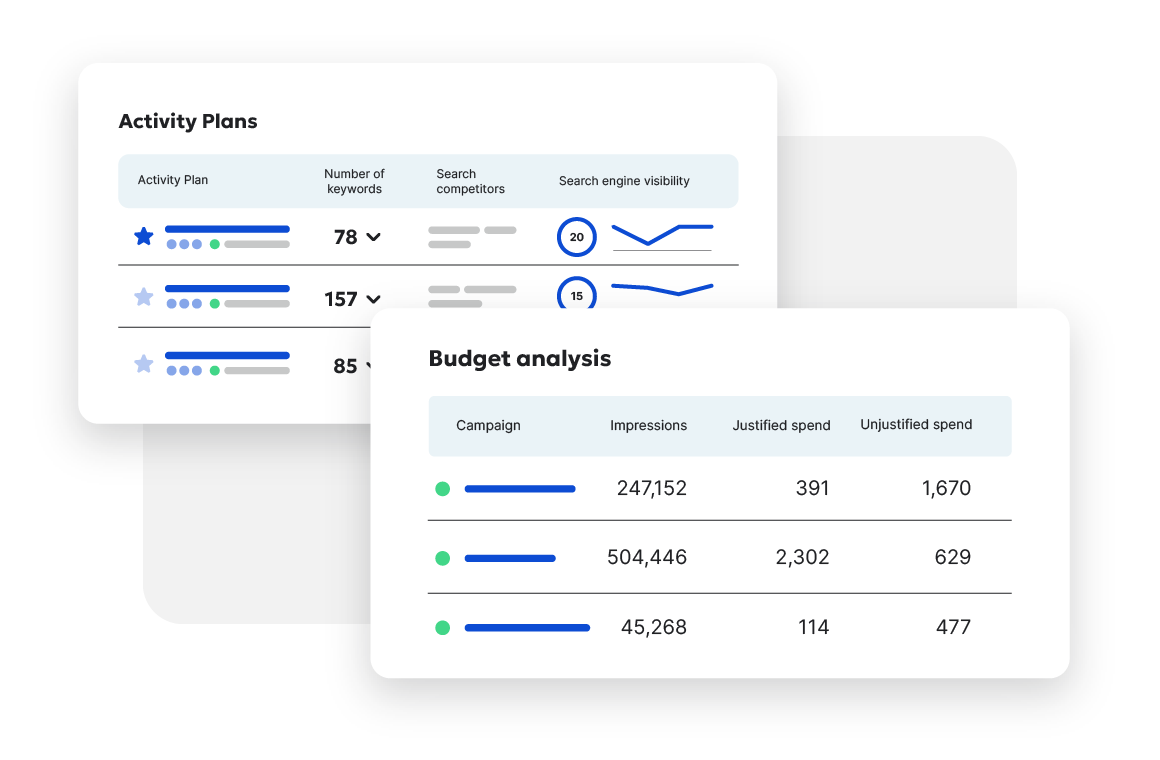Effective marketing involves learning how to think like your prospects. You need to anticipate the users’ needs when they’re looking for a solution like yours. That’s where lower funnel search intent comes in.
Search intent is the why behind a search. It’s the goal a searcher has when looking for something. Lower funnel search intent is when that why behind a search is close to a conversion. When you optimize your content with bottom-funnel search intent in mind, you can propel more leads through your sales funnel and boost your Google ranking results.
But divining user intent isn’t as intuitive as it sounds.
Let’s explore how you can use search intent to enhance your organic and paid marketing strategies.
What is lower-funnel search intent?
Search intent, sometimes referred to as keyword intent or user intent, is the direct goal of the person searching.
Google will reward those who really understand search intent with more visibility in both SEO and paid search, so it’s essential to take the time to research what users really mean when they search for specific keyphrases.
For example, if a user searches “best accounting software”, what content should an accounting software company create to address that user’s intent?
Here are two approaches, one of which has considered user search intent, while the other hasn’t:
#1: A sales page called “Best Accounting Software” that includes several paragraphs about why Company X is the best accounting software on the market and an offer for a free trial of their software.
#2: A blog post called “X Best Accounting Software Solutions of 2019” that includes a detailed and informative roundup of the world’s best accounting software, based on user reviews and objective data.
You guessed it — #2 is the much better approach, because a user who wants to read up on the best accounting software is likely to want a thoughtful comparison, rather than an advertisement for one company.
The three types of search intent: Know, Do, Go
There are three main types of search intent for all internet searches, including bottom-funnel searches. These are:
1. Informational searches (Know)
All of us conduct informational searches. It may be what brought you here to this page. When someone searches with the intent of gathering information, they want to know more about something. Bottom-funnel informational searches might look like any of the following:
- Quick stir fry recipe
- Best inexpensive interior paint
- How old is George Clooney?
Note that sometimes informational search queries are in the form of a question, but not always. Sometimes, the answer is a short-snippet response. Other times, it’s a comprehensive how-to guide. But in all cases, the searcher wants to leave with new knowledge — and may be ready to make a buying decision based on that knowledge.
2. Transactional searches (Do)
A transactional search is performed when someone knows they want to buy something. Examples include:
- Buy tennis racket
- Orthopedic mattress pad
- Affordable running shoes
These types of searches might end in a sale or they might not. What’s important is that the searcher knows they want to buy something, and that they plan to eventually buy a specific product or service.
3. Navigational searches (Go)
When someone performs a navigational search, they already know where they want to end up, but they just need some help getting there. Examples include:
- Gourmet Makes YouTube
- My bank login
At this point, the searcher has made up their mind already about their destination — so your content should make it easy to find that specific URL or location.
Now, how do we use search intent to accelerate your SEO and paid search strategies?
Putting search intent to work
Search intent should drive the content you create, not keywords alone. Every day, Google’s algorithm becomes more capable of divining the intent behind the keywords — which means you should, too.
This isn’t to say that keywords aren’t important, only that your approach to using them may need to shift. Work backward from your ideal keywords to optimize your content for intent, and you’ll end up in front of the right searchers at the right time.
Choosing the right bottom-funnel keywords
If you’re using a tool like Siteimprove, you may already have an idea of your target keywords’ search volume, cost-per-click, and competitive density. As you know, keyword efficiency is every bit as important to your SEO or PPC campaign as the content you create — after all, if you’re a new company with a small budget you’ll have a much harder time ranking for high-volume, high-competition keywords.
When you select new lower-funnel keywords for your campaigns, filter potential keywords based on the parameters that make sense for your business.
Then, you can begin divining search intent from the keywords that remain.
Here’s an example.
Let’s say you run a financial startup that helps people consolidate their credit card debt. You’ve chosen a pool of lower-funnel keywords you would like to rank for (or bid on) based on your marketing strategy. One of these keyphrases is “credit card consolidation.”
Optimizing for search intent
Here are a few ways to determine user intent.
Consider the user’s emotions. If someone is searching for “credit card consolidation,” what are they feeling? Odds are, they’re frustrated because they’re looking for a more manageable way to pay off their debt. They might also be experiencing financial struggles, so they may be overwhelmed and nervous about the future. If you were frustrated and struggling financially, what kind of content would give you hope?
Refer to “know, do, go.” Look back at the three types of searches, and determine whether this is an informational, transactional, or navigational search. In this case, the user probably wants information: on their options for repayment, an explanation of consolidation, and where they can go to consolidate their debts. This might also be a transactional search if the user is ready to consolidate and they’re already comparing offers.
Use Google. When you search your keyphrase on Google, check what’s under “People also ask.” This will often give you clues about intent:
Many of these questions are directly related to the main topic and might be good subheads within a content piece.
Study keyword modifiers. Some keyword modifiers suggest types of search intent. “How,” “When,” and “Who” are all driven toward information; whereas “Buy,” “Cheap,” and “Sale” are generally transaction-driven. In this case, there are no explicit modifiers — but there are a few implied ones:
- What are credit card consolidation repayment plans
- Where can I find debt consolidation repayment plans
- Best credit card debt consolidation repayment plans
Look at your content competitors. Your content competitors are those who outrank you for a specific organic search term. They may or may not be your business competitors. A quick Google search of the target keyphrase in our example reveals several ads above the fold, all of which are for financial companies offering a similar solution. This can give you an idea of the content your target users are seeing from other paid search campaigns, which can inform your PPC strategy. As for SEO, the first organic result is a featured snippet from ConsolidatedCredit.org, followed by two informational pages from financial companies.
Bonus considerations
Here are some other things to consider when optimizing your SEO and PPC lower-funnel keywords for search intent.
Improve existing content
If you’re already ranking for some bottom-funnel search terms, return to that ranking content and modify it to better align with your target audience’s search intent. You’ll see a much faster boost in rankings by improving existing content than creating new content from scratch. Here are key elements to address when optimizing old content for search intent:
- The title. Does the title contain the target keyphrase in a meaningful way?
- Introduction content. Does the piece get to the point quickly and offer a concise answer to the searcher’s question?
- Do they address related topics? Does the content in each section measure up to the promises each header makes?
- Is this piece of content structured in the best possible way for the user? In other words, is it easy for them to get the answers they seek with minimal effort?
Explore long-tail keyphrases
If your budget is limited or you’re a newer company, it pays to focus on bottom funnel long-tail keyphrases. For example, instead of a broad term like “IT consulting company”, opt for:
- IT consulting company in [your location]
- IT infrastructure consulting services for small accounting businesses
- IT security consultant in [your location]
When creating content for long-tail keyphrases like these, search intent is fairly clear: a user wants to find a specific company like yours but may not know you exist (yet).
Key learning: bottom-funnel searchers are wavering between consideration and making a decision. It’s the sweet spot where you have the power to tip the balance one way or the other with your content — and when you meet your users halfway with the best content on the internet, they’ll reward you with their business.

Ready to improve your Search Engine Optimization?
Siteimprove SEO is an all-in-one Enterprise SEO tool that can help you achieve your digital potential.
Schedule a demo